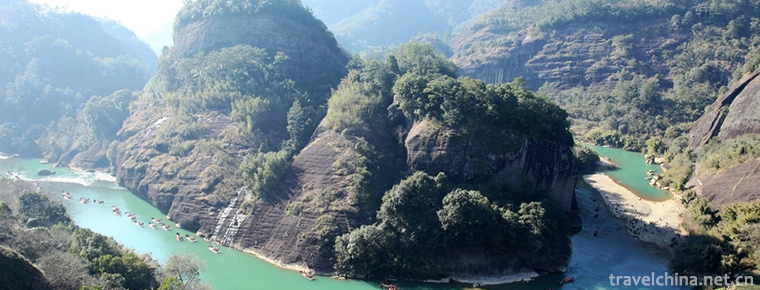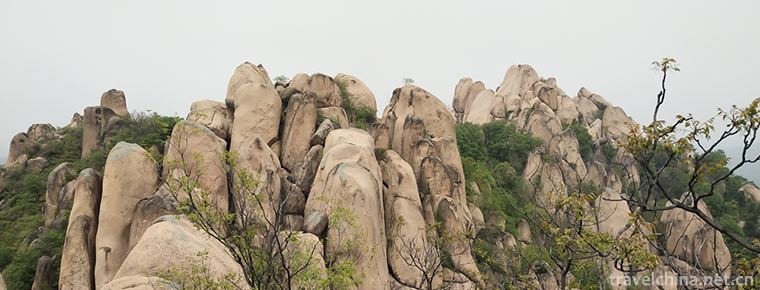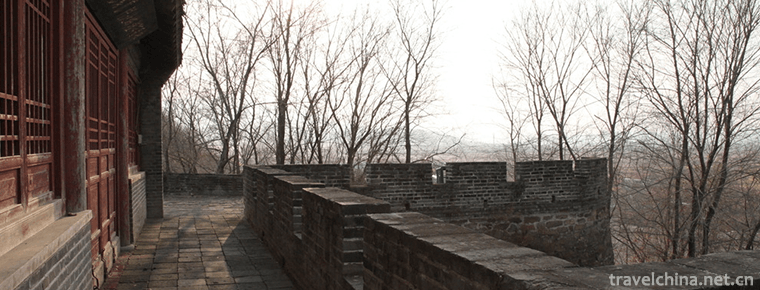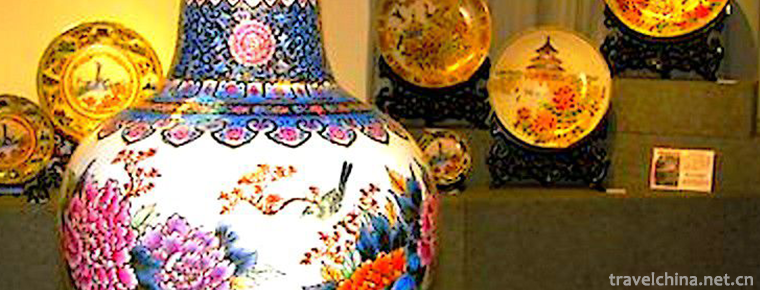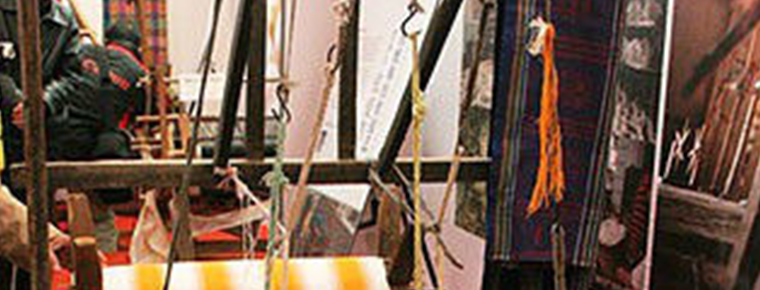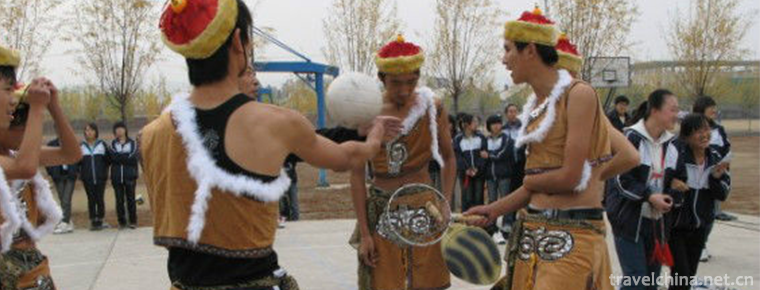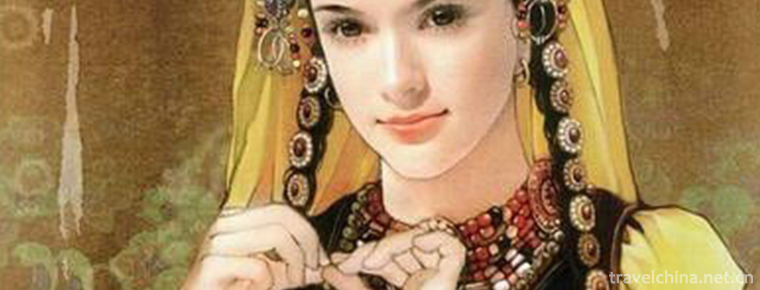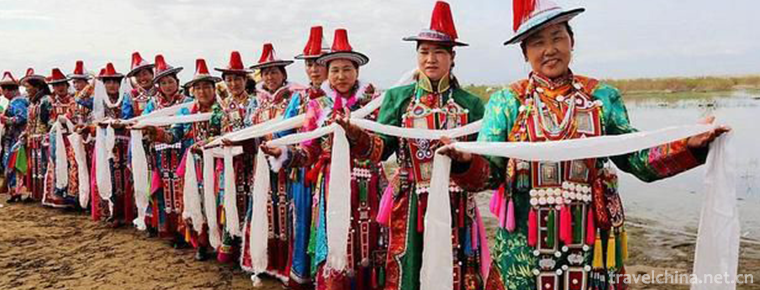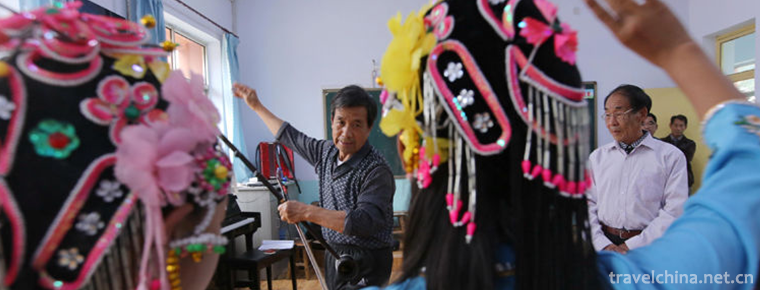Expo Area of Acient Kiln Folk Cultures in Jingde
Expo Area of Acient Kiln Folk Cultures in Jingde
Jingdezhen Ancient Kiln Folklore Expo Area, located in Fengshu Mountain and Panlonggang, Changjiang District, Jingdezhen City, Jiangxi Province, covers an area of 83 hectares. It is a cultural tourist attraction integrating cultural exposition, ceramic experience, entertainment and leisure. It is the only national tourist attraction with ceramic culture as its theme.
The main attractions of Jingdezhen Ancient Kiln Folklore Expo Area are ancient kiln exhibition area, ceramic folk exhibition area and creative recreation area of Waterfront Street. In April 2013, Jingdezhen Ancient Kiln Folklore Expo won the honorary title of "National AAAAA Class Tourist Scenic Spot".
Historical evolution
Jingdezhen Ancient Kiln was built in the Five Dynasties and developed continuously after the Song, Yuan, Ming and Qing Dynasties.
In 1980, the construction of Jingdezhen Ancient Kiln Folklore Expo began. The government decided to centralize the protection of some ancient kilns, workshops and buildings scattered in the urban areas, forming a cultural tourism scenic spot covering 83 hectares, integrating cultural exposition, ceramic experience and entertainment and leisure.
In 2004, Jingdezhen Ancient Kiln Folklore Expo Area was rated as AAAA class tourist attraction by the National Tourism Administration.
On November 30, 2011, Jingdezhen Ancient Kiln Folklore Expo launched the ceremony of creating a national 5A tourist attraction.
In April 2013, Jingdezhen Ancient Kiln Folklore Expo was promoted to "National AAAAA Class Tourist Scenic Spot".
In June 2015, Jingdezhen Ancient Kiln Folklore Expo Area was awarded the National Science Popularization Education Base.
On June 11, 2016, construction of the Jiangxi Pavilion of the World Expo and the twin kiln of the Lion Kiln of the Qing Dynasty began.
geographical position
Jingdezhen Ancient Kiln Folklore Expo Area is located in Fengshu Mountain Panlonggang, Changjiang District, Jingdezhen City, No. 1 Ancient Kiln Road, Porcelain Capital Avenue, covering an area of 83 hectares. It is adjacent to Jingdezhen College and Yilong Hotel.
Layout of scenic spots
The scenic area is divided into three major areas: ancient kiln exhibition area, ceramic folk exhibition area and creative recreation area of Shuiquan Qianjie.
There are ancient porcelain workshops, the world's oldest production line, Qing Dynasty town kilns, Ming Dynasty gourd kilns, Yuan Dynasty steamed bread kilns, Song Dynasty dragon kilns, Fenghuo Xianshi Temple, porcelain shops and other scenic spots in the exhibition area of ancient kilns. The process of Jingdezhen hand-made porcelain in Ming and Qing Dynasties and traditional famous porcelain products.
There are twelve ancient buildings of Ming and Qing dynasties in the exhibition area of ceramic folklore, including the exhibition of ceramic folklore, the Tianhou Palace, the promenade of ceramic tablets, and the performance of porcelain music on the water stage.
In the creative recreation area of Shuibian Qianjie, there are creative leisure landscape of porcelain culture such as Changnan interrogation porcelain, Changnan wharf, Tinghe Taoyan, Qianjie present life, wood-ceramic front, etc.
Main attractions
Steamed bun kiln in Yuan Dynasty
Steamed bread kiln is one of the typical porcelain kilns used in Jingdezhen in Song, Yuan and Ming Dynasties. It is named for its similar shape to steamed bread. Some steamed bread kilns have horseshoe-shaped beds on the plane, so they are also called horseshoe-shaped kilns. The firing temperature can be as high as 13 Baidu and a reducing atmosphere can be formed. Through the continuous exploration of Jingdezhen kiln workers, the construction and firing skills of Yuan and Ming steamed bread kilns reached the highest level of the traditional porcelain kilns in China.
Song Dynasty dragon kiln
Dragon kiln is one of the traditional ceramic kilns in China. The kiln is tilted and built according to the mountain situation. It is named for its dragon-like shape. Dragon kiln has simple structure, which is divided into three parts: kiln head, kiln bed and kiln tail. Generally, the fuel is grass, branches, etc. The utility model has the advantages of low cost, large loading and burning capacity, and can make full use of waste heat. Using natural hillside construction, the flame pumping force is large, and the reducing atmosphere of firing celadon and shadow celadon can be formed. Longyao made outstanding contributions to the prosperity of Jingdezhen's porcelain industry in Song Dynasty. Longyao sites of Song Dynasty were found in Hutian, Yaoli and Liyang of Jingdezhen.
Hulu Kiln in Ming Dynasty
Hulu kiln is the abbreviation of Jingdezhen Hulu-shaped firewood kiln. Hulu kiln is a unique porcelain kiln in Jingdezhen. It first appeared in the late Yuan and early Ming Dynasty. It was not used until the egg-shaped kiln appeared in the early Qing Dynasty. Song Yingxing's Tiangong Kaiwu in Ming Dynasty has special written records and illustrations of the gourd kiln in Jingdezhen. The Hulu kiln in Ming Dynasty has the advantages of both the Longyao kiln and the steamed bread kiln in Song and Yuan Dynasties. The firing technology has made great progress, and has made outstanding contributions to the development of Jingdezhen porcelain industry in Ming Dynasty and the formation of Zhenkiln in Qing Dynasty.
Town kiln in Qing Dynasty
Zhenyao in Qing Dynasty (abbreviated as "Zhenyao") is a kind of porcelain kiln with unique style in traditional kilns in China. The kiln house is a funny wooden frame building. The total length is 15 - 20 meters, the volume is about 300 cubic meters, and the highest is about 6 meters. Matsushi is used as fuel in firing (so it is also called "Chai Kiln"). The flame is long and ash content is low. It does not contain harmful substances. It is suitable for firing reduction flame. It has good color rendering effect for white, blue and white porcelain, color glaze and so on. Zhenyao is the most complete and valuable ancient kiln till now. On July 25, 2000, Jiangxi Provincial People's Government announced it as a key cultural relics protection unit at the provincial level.
Porcelain Pavilion
Porcelain Ou, a new national percussion instrument, is used as the main material to perform Chinese music. Porcelain Orchestra first appeared at the "99" Kunming World Expo, causing a sensation. In 2000, Comrade Qian Qichen, then Minister of Foreign Affairs, was delighted to inscribe "the magic charm of porcelain" after listening to the porcelain music. Porcelain orchestras have performed in more than a dozen countries and regions, such as Japan and Russia, where they have been warmly welcomed.
small furnishings
This workshop mainly produces small pieces of utensils, mainly daily-use porcelain, including bowls, cups, cups, dishes and other varieties, with exquisite texture and regular shape. It is known for its white jade, bright mirror, thin paper and sound.
Porcelain workshop
Porcelain workshop, commonly known as "green house", is a factory building for making ceramic bodies and underglaze paintings of ceramic bodies. With the obvious nature of early capitalism sprouting, porcelain workshop building has become a rare existing example of ancient industrial buildings in China, and a real example of the existence of capitalism sprouting in Ming and Qing Dynasties.
Ming Lu
"
Minglu has eight buildings, such as Lumen, shops, ancestral halls and houses. In December 1987, the People's Government of Jiangxi Province announced it as a key cultural relics protection unit at the provincial level.
Qingyuan
"Qingyuan" has four Qing Dynasty buildings, namely "Yuhua Hall", "Doctor's Day", "Cangxi Residence" and "Kiln Chaihang Boss's Residence". The whole building stands high and the materials are exquisite. In December 1987, the Jiangxi Provincial People's Government announced it as a key cultural relic protection unit at the provincial level.
Tang Ying Memorial
Tang Ying (1682-1756) was born in Fengtian, Qing Dynasty (Shenyang, Liaoning Province today), and was under the White Banner of the Han Army. The word Jungong, from the name of the snail sent to the elderly. Yongzheng in the Qing Dynasty (1728) was appointed as associate director of Jingdezhen Imperial Factory. In the first year of Qianlong (1736), he managed Huai'an Guan and Jiujiang Guan and kiln business, until 21 years, and for more than 20 years he managed Jingdezhen Imperial Factory. Dedicated to the research of ceramic technology, great achievements have been made in archaism and innovation. The pottery inspected is called "Tang Kiln". His works Taocheng Chronicle, Taoyetushuo and Taoren Xinyu are all important documents for studying the history of Jingdezhen porcelain making. In order to remember the past and inherit and develop the excellent culture of the Chinese nation, the Tang Ying Memorial Hall has been established.
Fenghuo Xianshi Temple
Fenghuo Xianshi Temple was built in Jiaqing period of Qing Dynasty (1796 - 1820). It has two parts: the building sharing hall and the dormitory, covering an area of 485 square meters. In January 1989, the building was declared as a key cultural relic protection unit in Jingdezhen.
Large piece work
This workshop mainly produces large plates, bottles, vats, and other display porcelain. Its products are difficult to manufacture and have high technical requirements.
Famous specialty products
The main specialties of Jingdezhen include: Jingdezhen porcelain, Leping dog meat, Leping flower pig, Fuliang tea, Yao Li Nen tea, sepiolite, porcelain clay stewed chicken, Cai Jia taro, etc.
Scenic spot activities
Jingdezhen International Ceramic Festival
Every mid-October, Jingdezhen International Ceramic Festival is held in Jingdezhen. During the festival, trade talks and exhibitions of fine ceramics will be held.
Ancient kiln complex firing
On March 18, 2015, at 15:18, Guyao Folklore Expo
The Ming Dynasty gourd kiln in the scenic area is the first kiln to be fired in the ancient kiln in 2015. Since March 2015, ancient kilns have been burned regularly every month. Visitors to the ancient kiln will have more chances to watch Chai kiln firing porcelain, and enjoy the grand occasion of opening the kiln and exporting the porcelain on the weekend.
By the end of 2015, the Qing Dynasty town kiln, Ming Dynasty gourd kiln, Yuan Dynasty steamed bread kiln, Song Dynasty dragon kiln, Ming and Qing Dynasty imperial kiln in the Qing Dynasty, Longguan kiln, Fenghuo kiln, one by one, successfully reburned.
Porcelain Fair
On October 11, 2015, the Porcelain Fair was held in Jingdezhen Ancient Kiln Folklore Expo Area. There were three activities in the Porcelain Fair. First, the bronze statue of the kiln prodigy Bin opens at 09:00 a.m. to bless the potters of all ages; second, the 10:38 Zhimeixuan Ceramic Exhibition Hall opens a treasure house of knowledge; third, the 11:18 Ming and Qing dynasties use the wind-fired kiln to open the kiln and light the Millennium kiln fire.
Porcelain performance
Every day, there are performances by the "Porcelain Sound Water Elysees" Porcelain Orchestra from Monday to Friday (six performances): 9:30-9:50, 10:20-10:40, 11:10-11:30, 14:00-14:20, 14:50-15:10, 15:40-16:00;
From Saturday to Sunday: (four games) 9:30-9:50, 10:20-10:40, 11:10-11:30, 14:00-14:20.
Tourism information
traffic
The scenic spot is about ten minutes away from the airport, the high-speed intersection and the railway station.
Train
Jingdezhen Railway Station has 22 train flights, which can go directly to Kunming, Nanjing, Guangzhou, Taizhou, Shenzhen, Fuzhou, Beijing, Xiamen, Hefei, Qingdao, Shanghai and other places.
aviation
There are six domestic flights in Jingdezhen, which are to Beijing, Guangzhou, Shanghai, Shenzhen, Xiamen and Chengdu.
Self driving
1. Jingdezhen West Yingbin Avenue West Passenger Station right turn Porcelain Capital Avenue Kaimenzi Hotel oblique opposite right turn into Guyao Folklore Expo Area.
2. Jingdezhen North Jinling Avenue Amethyst Road Xishan Road Turn left on Porcelain Capital Avenue Kaimenzi Hotel Turn left into Guyao Folklore Expo Area.
Internal traffic
Take Bus No. 2, No. 5 and No. 9 in the city and get off at the Ceramic History Expo Station.
guide
Scenic spot accommodation
There are not many five-star hotels in Jingdezhen. The price of three-star hotels is about 2300 yuan, while that of four-star hotels is about 6700 yuan.
Ticket information
Adults 95 yuan, student tickets 50 yuan; children under 1.2 meters in height are exempted from tickets; elderly people over 70 years old are exempted from tickets by their ID card and "senior citizen's preferential treatment card"; retired servicemen, disabled veterans, retired army cadres with valid certificates, disabled persons (level 1 and 2) with their disability certificates, can enjoy the exemption after registration.
Opening hours: 8:00-17:00
Address: No. 1 Guyao Road, Porcelain Capital Avenue, Jingdezhen City.

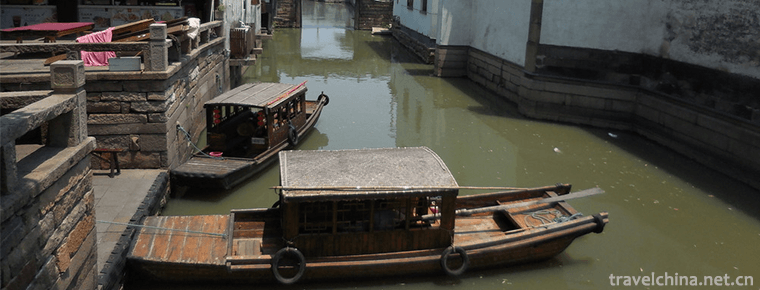
-
Mount Wuyi
Wuyi Mountain, Wuyi Mountain is located at the junction of Jiangxi and northwest Fujian Province. The southeastern foot of Wuyi Mountain has a total area of 999.75 square kilometers. It is a famous sc.
Views: 191 Time 2018-10-28 -
Aerhchin Mountains
Altyn Tagh is a mountain range in southeastern the Xinjiang Uygur Autonomous Region, China. The eastern end extends to the two provinces of Qinghai and Gansu.
Views: 253 Time 2018-11-01 -
Chengji Mountain Tourist Scenic Spot
Qiu Mountain, also known as Linglong Mountain, Xianshan Mountain on a journey to the West and Qiu Mountain Scenic Area, is located in Suiping County, Zhumadian City, Henan Province.
Views: 129 Time 2018-12-09 -
The ancient city of Hetuala
The ancient city of Hetuala is located in Yongling Town, Xinbin Manchu Autonomous County, Liaoning Province. It is 5 kilometers west of Qingyongling.
Views: 208 Time 2019-01-13 -
Firing Techniques of Chaozhou Coloured Porcelain
In Chaozhou at the end of the Qing Dynasty, new colored pigments were used in the colored porcelain painting. Combining traditional glaze painting art with traditional Chinese painting .
Views: 234 Time 2019-04-16 -
Traditional Cotton Textile Techniques
Chinese traditional textile technology has a long history. Since cotton was introduced from India in the 7th century, Chinese textile industry has changed from linen to cotton. .
Views: 220 Time 2019-04-19 -
Manchu Pearl Ball
Pearl ball is a traditional sport of Manchu, originally known as pearl picking, which originated from the ancient pearl picking production activities of Manchu. In the age of Taizu Nuerhachi in the Qi.
Views: 259 Time 2019-05-20 -
Tajik costumes
Tajik costume refers to the costume with distinct ethnic characteristics of Tajik. Tajik people mainly live in the Pamir Plateau with cold climate. Their economic life is mainly animal husbandry and a.
Views: 313 Time 2019-06-17 -
Yugur Costume
Yugur costume is the traditional costume of Yugur people. Both men and women of Yugur nationality wear long gowns with high collars and large skirts. Men wear red and blue belts with waistknives, sick.
Views: 138 Time 2019-07-16 -
Parrot Opera
Parrot Opera, which originated in the reign of Qianlong in Qing Dynasty, inherited in Shanghe Village, Linzi District, Zibo City, Shandong Province, and is one of the national intangible cultural heri.
Views: 142 Time 2019-07-25 -
Leshan Education
In 2018, Leshan Normal University, School of engineering and technology of Chengdu University of technology and Leshan vocational and technical college enrolled 16051 students, including 52775 students, 13837 graduates and 2509 full-time teachers..
Views: 352 Time 2020-12-17

